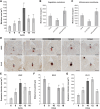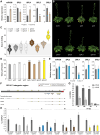The trehalose 6-phosphate pathway coordinates dynamic changes at the shoot apical meristem in Arabidopsis thaliana
- PMID: 40638795
- PMCID: PMC12415856
- DOI: 10.1093/plphys/kiaf300
The trehalose 6-phosphate pathway coordinates dynamic changes at the shoot apical meristem in Arabidopsis thaliana
Abstract
A plant's stem cell population in the shoot apical meristem (SAM) is maintained by WUSCHEL (WUS) and CLAVATA3 (CLV3). SAM size is dynamic and undergoes a more than 2-fold expansion upon transition to reproductive growth. The mechanism controlling this doming is largely unknown; however, coinciding increased trehalose 6-phosphate (T6P) levels suggest a participation of the T6P pathway in Arabidopsis (Arabidopsis thaliana). Moreover, lines misexpressing or with reduced expression of TREHALOSE PHOSPHATE SYNTHASE1 (TPS1) have smaller and larger SAMs, respectively. Here, we show that TREHALOSE PHOSPHATE PHOSPHATASEJ (TPPJ) is directly regulated by WUS. Changing TPPJ transcript levels in the outer layer affects SAM size and flowering time, and its reduction in the late-flowering clv3 mutant restores wild-type flowering. This is associated with altered mature microRNA156 abundance and expression of the SQUAMOSA PROMOTER-BINDING PROTEIN-LIKE genes SPL3, SPL4, SPL5, and SPL9. Furthermore, SPL4 is controlled by WUS, while SPL4 directly represses WUS, establishing negative feedback regulation. This feedback loop is important for age pathway-induced flowering involving the T6P pathway and suggests dynamic feedback regulations between central meristem maintenance and flowering time regulators with sugar signaling throughout development.
© The Author(s) 2025. Published by Oxford University Press on behalf of American Society of Plant Biologists.
Conflict of interest statement
Conflict of interest statement. None declared.
Figures







References
-
- Bernier G. The control of floral evocation and morphogenesis. Annu Rev Plant Physiol Plant Mol Biol. 1998:39(1):175–219. 10.1146/annurev.pp.39.060188.001135 - DOI
-
- Bertran Garcia de Olalla E, Cerise M, Rodriguez-Maroto G, Casanova-Ferrer P, Vayssieres A, Severing E, Lopez Sampere Y, Wang K, Schafer S, Formosa-Jordan P, et al. Coordination of shoot apical meristem shape and identity by APETALA2 during floral transition in Arabidopsis. Nat Commun. 2024:15(1):6930. 10.1038/s41467-024-51341-6 - DOI - PMC - PubMed
MeSH terms
Substances
Grants and funding
LinkOut - more resources
Full Text Sources

